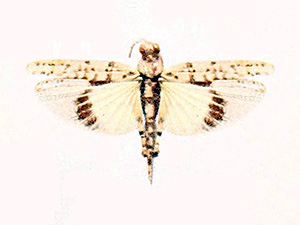Pahranagat Spinedace (Lepidomeda altivelis)
The Pahranagat Spinedace was described in 1960; the species is known from the outflows of The Ash Spring in the Pahranagat Valley in Nevada, USA, it preferred moderately swift, clear water.
The species was last recorded in 1938 and is now considered extinct; it disappeared most likely due to competition with- and predation by introduced fish- and frog species.
*********************
edited: 24.02.2024
Tag Archives: Nevada
Vorticifex solida (Dall)
The Solid Ramshorn was apparently described based on fossil- or subfossil shells, however, it appears to have survived until recently at least at one site: Lake Tahoe which is situated on the state line between California and Nevada, USA.
The status of the taxon appears to be completely unknown, it might be extinct or it might still be alive; it might furthermore be identical with another species, the Artemesian Ramshorn (Vorticifex effusa (I. Lea)) anyway.
*********************
edited: 22.01.2022
Pyrgulopsis nevadensis (Stearns)
Lake Pyramid Pyrg (Pyrgulopsis nevadensis)
The Lake Pyramid Pyrg was described in 1883, it was restricted to the Pyramid Lake in Washoe County in Nevada, USA.
The exact date of its disapeerance appears not to be known, however, the last specimens collected alive date from the very late 1800s, and despite the fact that shells are still commonly found, no living specimen was ever found since and the species is obviously extinct. [1]
***
The Lake Pyramid Pyrg also inhabited Walker Lake in Mineral County, Nevada, however, this population is only known from fossil remains and eppaers to be of Pleistocene age. [1]
*********************
References:
[1] Robert Hershler: A review of the North American freshwater snail genus Pyrgulopsis (Hydrobiidae). Smithsonian Contributions to Zoology 554: 1-115. 1994
*********************

http://www.inaturalist.org/people/coreyjlange
(under creative commons license (4.0))
http://creativecommons.org/licenses/by-nc/4.0
*********************
edited: 01.05.2019
Pyrgulopsis ruinosa Hershler
Fish Lake Pyrg (Pyrgulopsis ruinosa)
The Fish Lake Pyrg was described in 1998, it was restricted to its type locality, a single spring in the Fish Lake-Soda Spring Valleys in Esmeralda County, Nevada, USA.
The species was last recorded in 1988, its type locality is heavily decgraded and the species was never recorded since, it is extinct.
*********************
edited: 13.09.2020
Pyrgulopsis carinata Hershler
Carinate Duckwater Pyrg (Pyrgulopsis carinata)
The Carinate Duckwater Pyrg was described in 1998, it was restricted to a stretch of only about 20 m of outflow habitat of a single spring in the Hot creek-Railroad Valleys in Nye County, Nevada, USA.
The species was last found during surveys in 2009, but has since not be recorded and is thus considered most likely extinct.
*********************
edited: 18.05.2019
Rhinichthys deaconi R. R. Miller
Las Vegas Dace (Rhinichthys deaconi)
The Las Vegas Dace was described in 1984, it was declared extinct in 1986, only two years later.
***
The Las Vegas Valley in Nevada, USA originally was formed by a river, this river, however, started to disappear at 4000 to 1000 BCE., leaving behind only three springs and becoming merely a dry wash.
The last Las Vegas Daces were cought in 1940 (but were not recognized as being distinct), they apparently survived in one of the springs and outflows until 1955 to 1957, but disappeared sometimes before 1967.
The creek that formerly held the three springs is now obviously completely dry.
*********************
References:
[1] Robert Rush Miller: Rhinichthys deaconi, a new species of dace (Pisces: Cyprinidae) from southern Nevada. Occasional Papers of the Museum of Zoology University of Michigan 707: 1-21. 1984
*********************
edited: 23.04.2019
Neotamias umbrinus ssp. nevadensis (Burt)
Hidden Forest Chipmunk (Neotamias umbrinus ssp. nevadensis)
The Hidden Forest Chipmunk was a subspecies of the Uinta Chipmunk (Neotamias umbrinus (Allen)), that originally was described in 1931 as a subspecies of the Colorado Chipmunk (Neotamias quadrivittatus (Say)).
The Hidden Forest Chipmunk was restricted to the Hidden Forest in the Sheep Mountains in Clark County, Nevada, USA, where it inhabited areas above 2500 m. It was last seen in the 1960s and is now considered extinct.
*********************
References:
[1] Janet K. Braun; Aubrey A. Johnson; Michael A. Mares: Tamias umbrinus (Rodentia: Sciuridae). Mammalian Species 43(1): 216-227. 2011
*********************

Photo: Tdomhan
(under creative commons license (3.0))
http://creativecommons.org/licenses/by-sa/3.0
*********************
edited: 20.03.2018
Derotmema piute Rehn
Piute Band-winged Grasshopper (Derotmema piute)
This species was described in 1919, apparently from a single female specimen.
The Piute Band-winged Grasshopper was found near Mason, Lyon County in the desert of Nevada, USA.
The species was probably closely related to the Delicate Grasshopper (Derotmema delicatulum Scudder), from which it differed by its more robust form, its broader head and other characters. [1]
***
The Piute Band-winged Grasshopper is now considered possibly extinct, without any significant reasons known therefor.
*********************
References:
[1] James A. G. Rehn: Descriptions of new and critical notes upon previously known forms of North American Oedipodinae (Orthoptera; Acrididae). Transactions of the American Entomological Society 45: 229-255. 1919
*********************

(not in copyright)
*********************
edited: 05.12.2018
